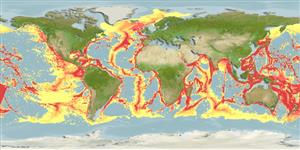Common names from other countries
Classification / Names / Names
ماع يماسا | فدارتم | Catalog of Fishes (gen., sp.) | ITIS | CoL | WoRMS
Environment: milieu / climate zone / depth range / distribution range
يسانش موب
یز حطس; قمع تارييغت 200 - 4000 m (Ref. 96968). Subtropical
Worldwide in tropical and subtropical waters.
Length at first maturity / Size / Weight / نس
Maturity: Lm ? range ? - ? cm Max length : 16.0 cm TL يسنج صاوخ نودب / رن سنج; (Ref. 96968)
Maximum depth from Ref. 110525. Depth range from 200 to 1,000 m. These small pelagic octopuses typically occur over deeper water as adults. Young animals tend to occur in the shallower end of the range. As members of this species reach sexual maturity the iridescence of the digestive gland and eyes is lost, and animals migrate to deeper darker waters in the later stages of the life cycle. Nearly mature males have salivary glands that are much larger than those of comparable females. Salivary products may be used as chemical attractant for females. The female light organ may be used for reproductive signalling to males (Ref. 96968).
Life cycle and mating behavior
غولب | لثم دیلوت | یزیر مخت | اه مخت | Fecundity | )ورال ( دازوت
Members of the class Cephalopoda are gonochoric. Male and female adults usually die shortly after spawning and brooding, respectively. Mating behavior: Males perform various displays to attract potential females for copulation. During copulation, male grasp the female and inserts the hectocotylus into the female's mantle cavity where fertilization usually occurs. Life cycle: Embryos hatch into planktonic stage and live for some time before they grow larger and take up a benthic existence as adults.
یلصا ذخآم
عجارم | هدننك گنهامه | ناراكمه
Turgeon, D.D., J.F. Quinn Jr., A.E. Bogan, E.V. Coan, F.G. Hochberg, W.G. Lyons, P.M. Mikkelsen, R.J. Neves, C.F.E. Roper, G. Rosenberg, B. Roth, A. Scheltema, F.G. Thompson, M. Vecchione and J.D. Willams. 1998. (Ref. 1667)
NCUI زمرق تسرهف رد تيعضو (Ref. 130435)
ستياس رظن زا تيعضو (Ref. 108899)
Not Evaluated
Not Evaluated
یناسنا هدافتسا
| FishSource |
اهرازبا
رتشيب تاعالطا
Age/Sizeدشرنزو - لوطلوط - لوطيسانش تخير)ورال ( دازوتيناوارف
يتنرتنيا عبانم
Estimates based on models
Preferred temperature
(Ref.
115969): 2.5 - 7.7, mean 4.1 (based on 3355 cells).
تميق هقبط
Unknown.
